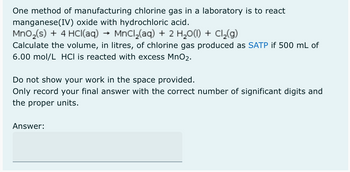
Chemistry
10th Edition
ISBN: 9781305957404
Author: Steven S. Zumdahl, Susan A. Zumdahl, Donald J. DeCoste
Publisher: Cengage Learning
expand_more
expand_more
format_list_bulleted
Concept explainers
Question

Transcribed Image Text:One method of manufacturing chlorine gas in a laboratory is to react
manganese(IV) oxide with hydrochloric acid.
MnO₂ (s) + 4 HCl(aq)
MnCl₂(aq) + 2 H₂O(l) + Cl₂(g)
Calculate the volume, in litres, of chlorine gas produced as SATP if 500 mL of
6.00 mol/L HCI is reacted with excess MnO2.
Do not show your work in the space provided.
Only record your final answer with the correct number of significant digits and
the proper units.
Answer:
Expert Solution
This question has been solved!
Explore an expertly crafted, step-by-step solution for a thorough understanding of key concepts.
Step by stepSolved in 2 steps with 2 images

Knowledge Booster
Learn more about
Need a deep-dive on the concept behind this application? Look no further. Learn more about this topic, chemistry and related others by exploring similar questions and additional content below.Similar questions
- Predict the reactants of this chemical reaction. That is, fill in the left side of the chemical equation. Be sure the equation you submit is balanced. (You can edit both sides of the equation to balance it, if you need to.) Note: you are writing the molecular, and not the net ionic equation. → CaC1,₂(aq) + H₂O(1) X Śarrow_forwardConsider the formation of chlorine gas, from household bleach (sodium hypochlorite) and hydrochloric acid. NaClO(aq) + 2 HCl(aq) → Cl2(g) + H2O(l) + NaCl(aq) If 13.5 ml of sodium hypochlorite (d = 1.11 g/ml) reacts with excess hydrochloric acid, what volume of chlorine gas will be collected over water at 20.0 oC? The lab barometer reads atmospheric pressure to be 755 mm Hg and the water vapor pressure at 20.0oC is 17.5 mm Hg. Question options: 4.05 L 4.75 L 4.39 L 4.99 Larrow_forwardMining companies use this reaction to obtain iron from iron ore: Fe₂O3(s) + 3 CO(g) → 2 Fe(s) + 3 CO₂(g) The reaction of 167 g Fe₂O3 with 85.8 g CO produces 72.3 g Fe. Determine the limiting reactant, theoretical yield, and percent yield. What volume (in mL) of 0.200 M NaOH do we need to titrate 35.00 mL of 0.140 M HBr to the equivalence point?arrow_forward
- Give the net ionic equation for the reaction (if any) that occurs when aqueous solutions of K 2S and Fe(NO 3) 2 are mixed.arrow_forwardWhat volume (in mL) of 0.300 M HCl would be required to completely react with 5.40 g of Al in the following chemical reaction? 2 Al(s) + 6 HCl(aq) → 2 AlCl₃ (aq) + 3 H₂ (g)arrow_forwardHow many moles of precipitate will be formed when 47.5 mL of 0.250 M AgNO₃ is reacted with excess CaBr₂ in the following chemical reaction? 2 AgNO₃(aq) + CaBr₂(aq) → 2 AgBr(s) + Ca(NO₃)₂(aq)arrow_forward
- What is the molarity of a hydrchloric acid, HCl, solution if it takes 26.90 mL of acid to neutralize 7.77 g of Fe(OH)3? The molar mass of Fe(OH)3 is 106.87 g/mol and the molar mass of HCl is 36.46 g/mol. The balanced chemical reaction is: 3 HCl (aq) + Fe(OH)3 (aq) → FeCl3 (aq) + 3 H2O (l)arrow_forwardWhat volume (in mL) of 0.200 M HCI would be required to completely react with 4.40 g of Al in the following chemical reaction? 2 Al(s) + 6 HCl(aq) → 2 AICI (aq) + 3 H₂(g)arrow_forwardConsider the following reaction. MgCl2(aq) + 2 NaOH(aq) → Mg(OH)2(s) + 2 NaCl(aq) A 185.0 mL solution of 0.395 M MgCl2 reacts with a 37.62 mL solution of 0.811 M NaOH to produce Mg(OH)2 and NaCl. Identify the limiting reactant. ○ Mg(OH)2 NaOH MgCl2 NaCl Caclulate the mass of Mg(OH)2 that can be produced. mass of Mg(OH)2: The actual mass of Mg(OH)2 isolated was 0.742 g. Calculate the percent yield of Mg(OH)2. percent yield: 6.0 g %arrow_forward
- What volume (in mL) of 0.150 M HCl would be required to completely react with 4.50 g of Al in the following chemical reaction? 2 Al(s) + 6 HCl(aq) → 2 AlCl₃ (aq) + 3 H₂(g)arrow_forwardA solution of NaCl(aq) is added slowly to a solution of lead nitrate, Pb(NO3)2(aq), until no further precipitation occurs. The precipitate is collected by filtration, dried, and weighed. A total of 17.07 g PbCl2(s) is obtained from 200.0 mL of the original solution. Calculate the molarity of the Pb(NO3)2(aq) solution.arrow_forwardHow many moles of precipitate will be formed when 78.5 mL of 0.300 M AgNO₃ is reacted with excess CaI₂ in the following chemical reaction? 2 AgNO₃ (aq) + CaI₂ (aq) → 2 AgI (s) + Ca(NO₃)₂ (aq)arrow_forward
arrow_back_ios
SEE MORE QUESTIONS
arrow_forward_ios
Recommended textbooks for you
 ChemistryChemistryISBN:9781305957404Author:Steven S. Zumdahl, Susan A. Zumdahl, Donald J. DeCostePublisher:Cengage Learning
ChemistryChemistryISBN:9781305957404Author:Steven S. Zumdahl, Susan A. Zumdahl, Donald J. DeCostePublisher:Cengage Learning ChemistryChemistryISBN:9781259911156Author:Raymond Chang Dr., Jason Overby ProfessorPublisher:McGraw-Hill Education
ChemistryChemistryISBN:9781259911156Author:Raymond Chang Dr., Jason Overby ProfessorPublisher:McGraw-Hill Education Principles of Instrumental AnalysisChemistryISBN:9781305577213Author:Douglas A. Skoog, F. James Holler, Stanley R. CrouchPublisher:Cengage Learning
Principles of Instrumental AnalysisChemistryISBN:9781305577213Author:Douglas A. Skoog, F. James Holler, Stanley R. CrouchPublisher:Cengage Learning Organic ChemistryChemistryISBN:9780078021558Author:Janice Gorzynski Smith Dr.Publisher:McGraw-Hill Education
Organic ChemistryChemistryISBN:9780078021558Author:Janice Gorzynski Smith Dr.Publisher:McGraw-Hill Education Chemistry: Principles and ReactionsChemistryISBN:9781305079373Author:William L. Masterton, Cecile N. HurleyPublisher:Cengage Learning
Chemistry: Principles and ReactionsChemistryISBN:9781305079373Author:William L. Masterton, Cecile N. HurleyPublisher:Cengage Learning Elementary Principles of Chemical Processes, Bind...ChemistryISBN:9781118431221Author:Richard M. Felder, Ronald W. Rousseau, Lisa G. BullardPublisher:WILEY
Elementary Principles of Chemical Processes, Bind...ChemistryISBN:9781118431221Author:Richard M. Felder, Ronald W. Rousseau, Lisa G. BullardPublisher:WILEY

Chemistry
Chemistry
ISBN:9781305957404
Author:Steven S. Zumdahl, Susan A. Zumdahl, Donald J. DeCoste
Publisher:Cengage Learning

Chemistry
Chemistry
ISBN:9781259911156
Author:Raymond Chang Dr., Jason Overby Professor
Publisher:McGraw-Hill Education

Principles of Instrumental Analysis
Chemistry
ISBN:9781305577213
Author:Douglas A. Skoog, F. James Holler, Stanley R. Crouch
Publisher:Cengage Learning

Organic Chemistry
Chemistry
ISBN:9780078021558
Author:Janice Gorzynski Smith Dr.
Publisher:McGraw-Hill Education

Chemistry: Principles and Reactions
Chemistry
ISBN:9781305079373
Author:William L. Masterton, Cecile N. Hurley
Publisher:Cengage Learning

Elementary Principles of Chemical Processes, Bind...
Chemistry
ISBN:9781118431221
Author:Richard M. Felder, Ronald W. Rousseau, Lisa G. Bullard
Publisher:WILEY